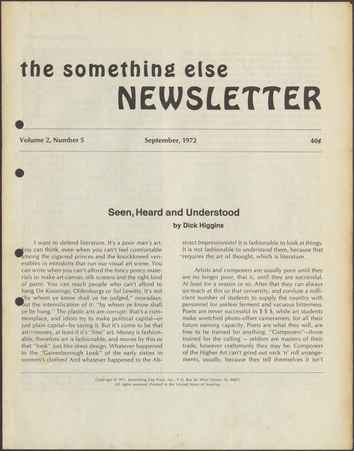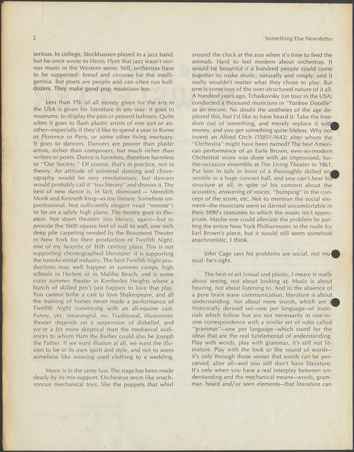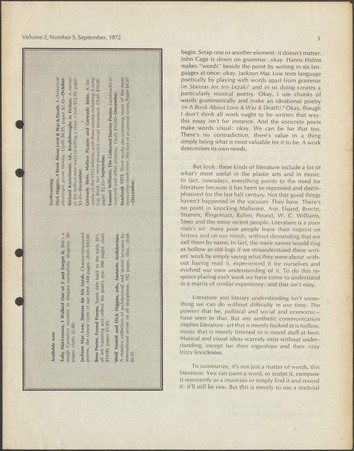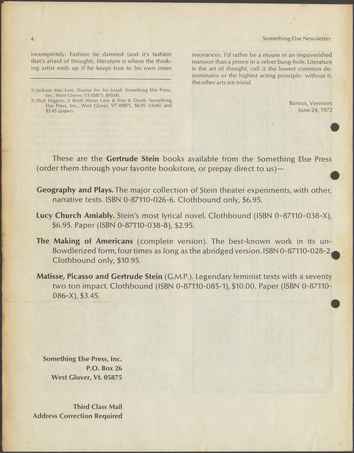Henning Christiansen
1972-09-00
Ophavsmand/nøgleperson
Something Else Press
Dokumentindhold
Dick Higgins, "Seen, Heard and Understood"/Bøger fra Something Else Press
Transskription
the something else
NEWSLETTER
Volume 2, Number 5 September, 1972 40c
*Seen, Heard and Understood
by Dick Higgins
*
I want to defend literature. It’s a poor man’s art. You can think, even when you can’t feel comfortable among the cigarred princes and the knockkneed venerables in miniskirts that run our visual art scene. You can write when you can’t afford the foncy poncy materials to make art-canvas, silk screens and the right kind of paint. You can reach people who can’t afford to hang De Koonings, Oldenburgs or Sol Lewitts. It’s not “by whom ye know shall ye be judged,” nowadays, but the intensification of it: “by whom ye know shall ye be hung.” The plastic arts are corrupt: that’s a commonplace, and idiots try to make political capital – or just plain capital – by saying it. But it’s come to be that art=money, at least if it’s “fine” art. Money is fashionable, therefore art is fashionable, and moves by this or that “look” just like dress design. Whatever happened to the “Gainesborough Look” of the early sixties in women’s clothes? And whatever happened to the Abstract Impressionists? It is fashionable to look at things. It is not fashionable to understand them, because that requires the art of thought, which is literature.
Artists and composers are usually poor until they are no longer poor, that is, until they are successful. At least for a season or so. After that they can always un-teach at this or that university, and confuse a sufficient number of students to supply the country with personnel for useless ferment and vacuous bitterness. Poets are never successful in $ $ $, while art students make wretched photo-offset cameramen, for all their future earning capacity. Poets are what they will, are free to be trained for anything. “Composers” – those trained for the calling – seldom are masters of their trade, however craftsmanly they may be. Composers of the Higher Art can’t grind out rock ‘n’ roll arrangements, usually, because they tell themselves it isn’t
Copyright © 1971. Something Else Press, Inc., P.O. Box 26, West Glover, Vt. 05875.
All rights reserved. Printed in the United States of America.
[s. 2]
2 Something Else Newsletter
serious. Stockhausen played in a jazz band, but he once wrote to Henry Flynt that jazz wasn’t serious music in the Western sense. Still, orchestras have to be supported: bread and circuses for the intelligentsia. But poets are people and can often run bulldozers. They make good pop musicians too.
Less than 1% of all money given for the arts in the USA is given for literature in any way. It goes to museums, to display the past or present fashions. Quite often it goes to flash plastic artists of one sort or another – especially if they’d like to spend a year in Rome or Florence or Paris, or some other living mortuary. It goes to dancers. Dancers are poorer than plastic artists, richer than composers, but much richer than writers or poets. Dance is harmless, therefore harmless to “Our Society.” Of course, that’s in practice, not in theory. An attitude of universal dancing and choreography would be very revolutionary, but dancers would probably call it “too literary” and dismiss it. The best of new dance is, in fact, dismissed – Meredith Monk and Kenneth King – as too literary. Somehow unprofessional. Not sufficiently elegant (rad “remote”) to be on a safely high plane. The money goes to theaters. Not street theaters (too literary, again) – but to provide the 1600 square feet of wall to wall, one inch deep pile carpeting needed byt the Beaumont Theater in New York for their production of Twelfth Night, one of my favorite of 16th century plays. This is not supporting choreographed literature: it is supporting the tuxedo-rental industry. The best Twelfth Night producions may well happen in summer camps, high schools in Harlem or in Malibu Beach, and is some crazy summer theater in Kimberley Heights wehere a bunch of skilled pro’s just happen to love that play. You cannot bribe a cast to love Shakespeare, and all the training of horses never made a performance of Twelfth Night convincing with an all-equine cast. Funny, yes: meaningful, no. Traditional illusionistic theater depends on a suspension of disbelief, and we’re a bit more skeptical than the mediaeval audiences to whom Ham the Barber could also be Joseph the Father. If we want illusion at all, we want the illusion to be in its own spirit and style, and not to seem somehow like wearing used clothing to a wedding.
Music is in the same fuss. The stage has been mad deady by its mis-support. Orchestras seem like anachronous mechanical toys, like the puppets that whirl around the clock at the zoo when it’s time to feed the animals. Hard to feel modern about orchestras. It would be beautiful if a hundred people could come together to make music, naturally and simply, and it really wouldn’t matter what they chose to play. But one is conscious of the over-structured nature of it all. A hundred years ago, Tchaikovsky (on tour in the USA) conducted a thousand musicians in “Yankee Doodle” as an encore. No doubt the esthetes of the age deplored this, but I’d like to have heard it. Take the freedom out of something, and merely replace it with money, and you get something quite lifeless. Why not invent an Alfred Orch (1585?-1642) after whom the “Orchestra” might have been named? The best American performance of an Earle Brown, ever-so-moddern Orchestral score was done with an improvised, for-the-occasion ensemble at The Living Theater in 1961. Put him in tails in front of a thoroughly skilled ensemble in a huge concert hall, and you can’t hear his structure at all, in spite of his concern about the acoustics, answering of voices, “bumping” in the concept of the score, etc. Not to mention the societal element – the musicians seem so darned uncomfortable in their 1890’s costumes to which the music isn’t appropriate. Maybe one could alleviate the problem by putting the entire New York Philharmonic in the nude for Earl Brown’s piece, but it would still seem somehow anachronistic, I think.
John Cage says his problems are social, not musical: he’s right.
The best of art (visual and plastic, I mean) is really about seeing, not about looking at. Music is about hearing, not about listening to. And in the absence of a pure brain wave communication, literature is about understanding, not about mere words, which are a historically derivated set – one per language – of materials which follow but are not necessarily in one-to-one correspondence with a similar set of rules called “grammar” – one per langage – which stand for the ideas that are the real fundamental fo understanding. Play with words, play with grammar, it’s still not literature. Play with the look or the sound of words – it’s only through those senses that words can be perceived, after all – and you still don’t have literature. It’s only when you have a real interplay between understanding and the mechanical means – words, grammar, heard and/or seen elements – that literature can
[s. 3]
Volume 2, Number 5, September, 1972 3
Available now
**Toby MacLennan, I Walked Out of 2 and Forgot It. **She’s a though Canadian novelist in elegant surrealistic disguise. 90 pages, cloth, $5.00.
**Jackson Mac Low, Stanzas for Iris Lezak. **Chance-structured poems, the classic cycle of our time. 448 pages, cloth $10.00.
**Bern Porter, Found Poems. **Some date back to the early 30’s, all are haunting and reflect the poet’s eye. 348 pages, cloth $10.00, paper $3.45.
**Wolf Vostell and Dick Higgins, eds.: Fantastic Architecture. **A massive collection of architectural and spatial turn-ons by international artists of all disciplines. 192 pages, illus., cloth $6.95.
Forthcoming
**Dick Higgins, A Book About Love & War & Death. **A chimerical aleotropic prose fantasy. Cloth $5.95, paper $2.45 – October.
**Richard Kostelanetz, ed., Breakthroughs in Fiction. **A survey of the million new ways of telling a story. Cloth $12.45, paper $3.45 – December.
**Gertrude Stein, Matisse, Picasso and Gertrude Stein. **A facsimile of the 1932 edition, with three sotries including A Logn Gay Book, her most powerful sexual testament. Cloth $10.00, paper $2.95 – September.
**Emmett Williams, The Collected Shorter Poems. **Landmarks in concrete and other poetries. Cloth $10.00 – December.
**Yearbook 1973. **Short works documenting many of the most innovative tendencies, the first of an annual series. Paper $4.50 – December.
begin. Scrap one or another element: it doesn’t matter. John Cage is down on grammar: okay. Hanns Helms makes “words” beside the point by writing in six languages at once: okay. Jackson Mac Low tests language poetically by playing with words apart from grammar (in Stanzas for Iris Lezak) (1) and in so doing creates a particularly musical poetry. Okay. I use chunks of words grammatically and make an ideational poetry (in A Book About Love & War & Death).(2) Okay, though I don’t think all work ought to be written that way: this essay isn’t for instance. And the concrete poets make words visual: okay. We can be for that too. There’s no contradiction, there’s value in a think simply being what is most valuable for it to be. A work determines its own needs.
But look: these kinds of literature include a lot of what’s most useful in the plastic arts and in music. In fact, nowadays, everything points to the need for literature because it has been so repressed and deemphasized for the last half century. Not that good things haven’t happened in the vacuum. They have. There’s no point in knocking Mallarmé, Arp, Eluard, Brecht,æ Stramm, Ringelnatz, Rühm, Pound, W.C. Williams, Stein and the more recent people. Literature is a poor man’s art: many poor people leave their imprint on history and on our minds, without demanding that we call them by name. In fact, the mere names would ring as hollow as old logs if we misunderstood these writers’ work by simply saying what they were about, without having read it, experienced it for ourselves and evolved our own understanding of it. To do this requires placing each work we have come to understand in a matrix of similar experience: and that isn’t easy.
Literature and literary understanding isn’t something we can do without difficulty in our time. The powers that be, political and social and economic – have seen to that. But any aesthetic communication implies literature: art that is merely looked at is hollow, music that is merely listened to is mood stuff at best. Musical and visual ideas scarcely exist without understanding, except for their cigarships and their ritzy fritzy knockees.
To summarize, it’s not just a matter of words, this literature. You can paint a word, or sculpt it, compose it resonantly as a musician or simply find it and record it: it’ll still be raw. But this is merely to use a material
[s. 4]
4 Something Else Newsletter
incompletely. Fashion be damned (and it’s fashion that’s afraid of thought), literature is where the thinking artist ends up if he keeps true to his own inner resonances. I’d rather be a mouse in an impoverished mansion than a prince in a velvet bung-hole. Literature is the art of thought, call it the lowest common denominator or the highest acting principle: without it, the other arts are trivial.
Barton, Vermont
June 24, 1972
1) Jackson Mac Low, Stanzas for Iris Lezak. Something Else Press, Inc., West Glover, VT 05875, $10.00
2) Dick Higgins, A Book About Love & War & Death, Something Else Press, Inc., West Glover, VT 05875, $6.95 (cloth) and $2.45 (paper).
These are the Gertrude Stein books available from the Something Else Press (order them through your favorite bookstore, or prepay direct to us)-
**Geography and Plays. **The major collection of Stein theater experimetns, with other, narrative texts. ISBN 0-87110-026-6. Clothbound only, $6.95.
**Lucy Church Amiably. **Stein’s most lyrical novel. Clothbound (ISBN 0-87110-038-X), $6.95. Paper (ISBN 0-87110-038-8), $2.95.
**The Making of Americans (complete version). **The best-known work in its un-Bowdlerized form, four times as long as the abridged version. ISBN 0-87110-028-2. Clothbound only, $10.95.
**Matisse, Picasso and Gertrude Stein (G.M.P.). **Legendary feminist text with a seventy two ton impact. Clothbound (ISBN 0-87110-085-1), $10.00. Paper (ISBN 0-87110-086-X), $3.45.
Something Else Press, Inc.
P.O. Box 26
West Glover, Vt. 05875
Third Class Mail
Address Correction Required
Fakta
PDFEngelsk
Something Else Press, Inc.
P.O. Box 26
West Glover, Vt. 05875
Bertolt Brecht
Earle Brown
John Cage
Willem de Kooning
Paul Éluard
Dick Higgins
Kenneth King
Richard Kostelanetz
Sol LeWitt
Toby MacLennan
Jackson MacLow
Stéphane Mallarmé
Henri Matisse
Meredith Monk
Claes Oldenburg
Pablo Picasso
Bern Porter
Ezra Pound
Joachim Ringelnatz
Gerhard Rühm
William Shakespeare
Gertrude Stein
Karlheinz Stockhausen
August Stramm
Pjotr Tjajkovskij
Wolf Vostell
Emmett Williams
William Carlos Williams
HC arkiv Møn/HC breve 12



